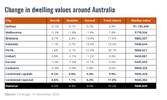- Joined
- 20 July 2021
- Posts
- 12,367
- Reactions
- 17,210
it is a sensible idea , soJust heard an interesting discussion on the radio. An English woman immigrated to Australia about 30 years ago, she retired a few years ago and recently looked at taking on a boarder to utilise her large home and get some extra spending money. Apparently, this is common in the UK and does not affect their pension.
Not possible in Australia. If she takes on a boarder, rents out a room, she will either lose part or all of her pension, and be inundated with taxation paperwork.
The discussion was about how many empty rooms are available to rent during the current rental crisis but are not on the market because of our complex and outdated taxation rules.
I can see nothing wrong with someone that has worked all their life and is now receiving a pension, being able to top up their income by renting a room or two. Alleviates multiple problems; increased income, improves the rental situation, improves social interaction and loneliness, helps maintain property through increase income for repairs, and so on.
1. it has to be banned
2. it has to be heavily regulated by government
and that is where we are ( while several Federal Members have interests in multiple investment houses/properties )


